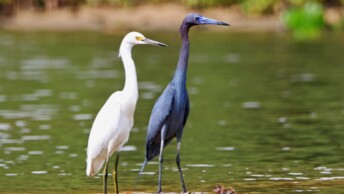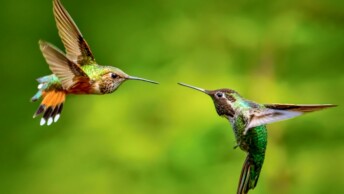Waterfowl are birds of the order Anseriformes, a group that includes the familiar ducks, geese, and swans (family Anatidae), along with the lesser-known screamers of South America (Anhimidae) and the unique magpie goose of northern Australia and southern New Guinea (Anseranatidae). Altogether, these families represent 171 living species adapted to aquatic environments around the world.
Ducks
- Identification: Small to medium-sized waterfowl with compact bodies, short necks, and broad bills; plumage ranges from dull to highly colorful.
- Where found: Widespread worldwide, inhabiting lakes, rivers, wetlands, and coastal waters; most diverse in North America, Eurasia, and Australasia.
- Conservation: Many species remain common and adaptable, though others face ongoing declines from habitat loss, hunting pressure, and pollution.
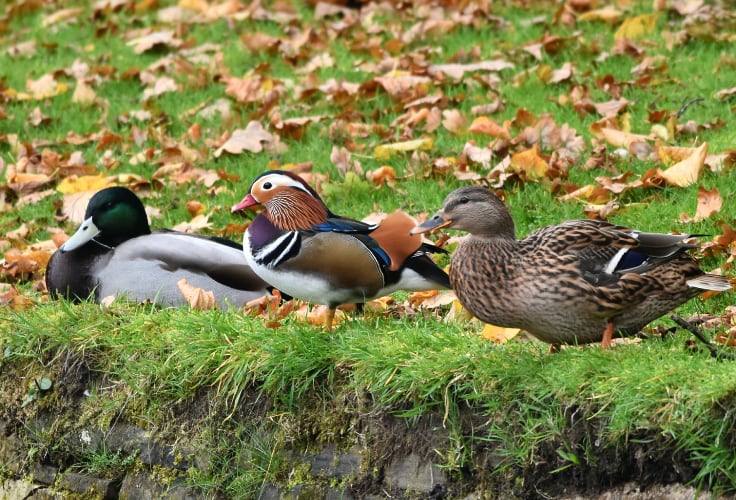
Ducks are the most diverse group of waterfowl, ranging from small teals to large eiders. They are generally compact, short-necked birds with broad, flattened bills and webbed feet adapted for swimming. Plumage varies widely, from the subdued browns and grays of many species to the brilliant patterns of mandarin ducks and wood ducks, which are among the most colorful birds in the world.
Ducks display an equally wide range of behaviors. Dabbling ducks feed at the surface or by tipping up in shallow water, while diving and sea ducks pursue prey underwater. Some specialize in grazing, filter-feeding, or catching invertebrates and fish. Most are highly social, forming flocks outside the breeding season, and many show elaborate courtship displays. Humans have long kept and hunted ducks, with species like the mallard giving rise to most domestic breeds.
Ducks occur worldwide, with the greatest diversity in North America, Eurasia, and Australasia. They inhabit nearly every type of wetland, from prairie potholes and forest ponds to coastal estuaries and open seas. Many are strongly migratory, with northern populations traveling long distances to wintering grounds; others, particularly in the tropics, remain resident year-round.
Conservation status varies across the group. Several species, such as the mallard and gadwall, remain abundant and adaptable, while others like the Brazilian merganser and Baer’s pochard face serious declines. Habitat loss, pollution, and hunting pressure have historically threatened many duck populations, though wetland protection and international treaties have led to recoveries in some cases.
Geese
- Identification: Medium to large waterfowl with long necks, sturdy bodies, and strong bills; plumage typically gray, brown, black, and white.
- Where found: Widely distributed across the Northern Hemisphere, with some species in Africa, Australasia, and South America.
- Conservation: Many populations stable or increasing due to adaptability and protection, though several species remain vulnerable to habitat loss and hunting.

Geese are medium to large waterfowl, heavier and longer-necked than most ducks but smaller than swans. They are generally marked in gray, brown, black, and white rather than bright colors, and often show bold facial or neck patterns that aid identification. Their sturdy bills and strong legs reflect a largely terrestrial lifestyle.
Geese are grazing birds, feeding primarily on grasses, sedges, and agricultural crops, though they also consume roots and aquatic vegetation. They are highly social, traveling in flocks outside the breeding season and forming strong pair bonds within family groups. Many species are well known for their loud calls and coordinated migratory flights, which have long made them familiar and symbolic birds to humans.
Most geese are native to temperate and arctic regions of the Northern Hemisphere, breeding in tundra, wetlands, and grasslands, and migrating south to milder climates in winter. Some, like the Canada goose, have adapted readily to urban parks and agricultural lands, while others remain more localized in remote breeding areas. A few species occur in Africa, Australasia, and South America.
While some geese have thrived under modern protection, others remain at risk. Species like the snow goose and Canada goose have expanded dramatically, even becoming agricultural pests in some regions, whereas the red-breasted goose and lesser white-fronted goose continue to struggle due to habitat loss, hunting, and climate change. International agreements and the safeguarding of critical breeding and wintering sites have supported recoveries, but ongoing management is essential.
Swans
- Identification: Largest waterfowl, with long necks, heavy bodies, and mostly white plumage; some species show black or mixed patterns.
- Where found: Native to the Northern Hemisphere, with additional species in Australia and South America; inhabit large lakes, rivers, and wetlands.
- Conservation: Several species have rebounded strongly after past declines, though others remain localized or vulnerable to habitat loss and human disturbance.
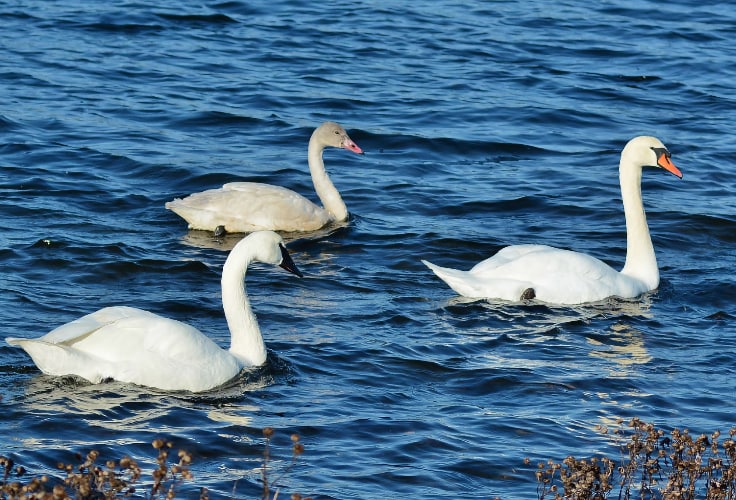
Swans are the largest of the waterfowl, instantly recognized by their long necks, heavy bodies, and graceful bearing. Most species are predominantly white, though the black swan of Australia and the black-necked swan of South America provide striking exceptions. Their size and elegance have made them some of the most iconic birds in human culture.
Swans are primarily herbivorous, feeding on aquatic plants and grasses, but they also graze on land and may consume crops. They are strongly territorial during the breeding season and are well known for forming lifelong pair bonds. Outside the nesting period, they can be social, gathering in flocks on lakes or estuaries. Their loud trumpeting or bugling calls carry over long distances.
These birds occur mainly in temperate and arctic regions of the Northern Hemisphere, breeding in wetlands, lakes, and slow-flowing rivers. The mute swan has been widely introduced outside its native Eurasian range and is now established in North America. In the Southern Hemisphere, the Black Swan is common in Australia, while the Black-necked Swan inhabits southern South America. Many species are migratory, moving south from northern breeding grounds to winter in milder climates.
Swans have faced serious declines in the past due to overhunting, egg collecting, and habitat loss, but conservation efforts have led to dramatic recoveries. The trumpeter swan, once near extinction in North America, now shows strong population growth, while tundra swan (Bewick’s subspecies) still depends on protected wetlands and safe migration corridors. Ongoing threats include wetland drainage, collisions with power lines, and disturbance in densely populated areas, but legal protection and habitat management have secured their future in many regions.
Screamers
- Identification: Large, long-legged waterfowl with goose-like bills and bare skin on the face; plumage mostly gray or black.
- Where found: Restricted to South America, inhabiting wetlands, marshes, and flooded grasslands.
- Conservation: Populations mostly stable, though habitat loss and hunting threaten some local areas.
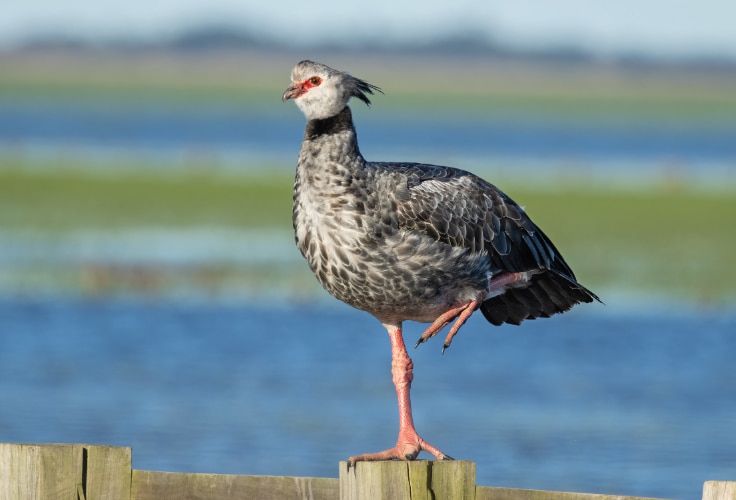
Screamers are unusual waterfowl that stand apart from the familiar ducks, geese, and swans. They are large, long-legged birds with broad wings, small down-curved bills, and a patch of bare skin on the face. Their plumage is mainly gray or black, and both sexes look alike. A distinctive feature is the sharp spurs on their wings, which they use in fights with rivals or predators.
Despite their goose-like appearance, screamers behave very differently. They are mainly herbivorous, grazing on aquatic and marsh vegetation, and their bodies are lighter than expected for their size, with air sacs under the skin that make them buoyant and capable of strong flight. Screamers are highly vocal, producing loud, far-carrying calls that give them their name. They form long-lasting pair bonds and are strongly territorial.
Screamers occur only in South America, with three living species: the horned screamer, northern screamer, and southern screamer. They inhabit wetlands, marshes, and flooded grasslands, often in regions with abundant floating vegetation. Their distribution ranges from Colombia and Venezuela south through Brazil, Bolivia, Argentina, and Paraguay.
Screamers remain generally secure across much of their range, though local populations can be affected by wetland drainage, hunting, and persecution as crop pests. Protecting large, healthy marshes and floodplains is essential to maintaining their numbers.
Magpie Goose
- Identification: Large, long-necked waterfowl with black-and-white plumage, bare facial skin, and strongly clawed feet for perching.
- Where found: Restricted to northern Australia and southern New Guinea, mainly in tropical wetlands and floodplains.
- Conservation: Populations generally stable, though local declines occur where wetlands are drained or heavily hunted.
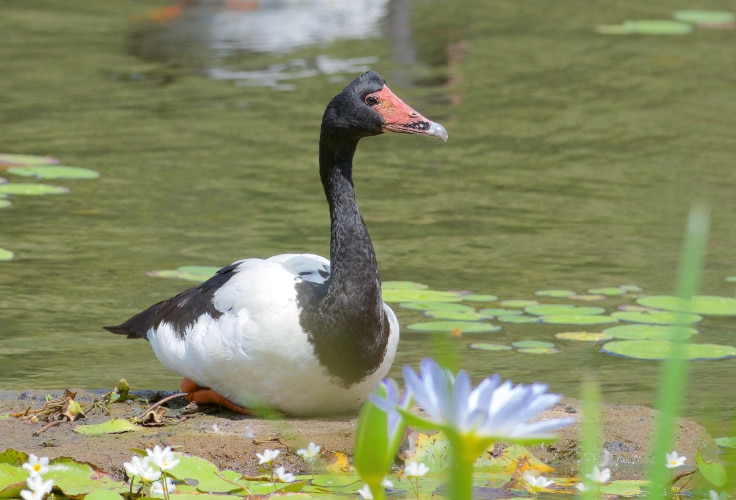
The magpie goose is a distinctive species representing its own ancient family within the waterfowl. It is a large, long-necked bird with bold black-and-white plumage, bare skin on the face, and unusually strong, clawed toes that allow it to perch in trees. Unlike most waterfowl, it has partially unwebbed feet and a unique skeletal structure that sets it apart from ducks, geese, and swans.
This species is highly social, forming large flocks in the non-breeding season. It feeds mainly on aquatic plants, grasses, and tubers, often grazing in shallow water or wet meadows. Breeding is unusual for waterfowl: males may pair with two females simultaneously, and all adults help raise the young. Indigenous peoples of northern Australia value the species as a food source, and it has long been a part of regional culture.
The magpie goose inhabits tropical northern Australia and southern New Guinea, where it relies on seasonal wetlands, floodplains, and swamps. It is well adapted to environments with fluctuating water levels, often moving in response to seasonal flooding and drought. During the wet season it disperses widely, while in the dry season it concentrates in large numbers around remaining water bodies.
Overall, the magpie goose remains widespread and secure in most of its range, though wetland drainage, altered water regimes, and hunting can reduce local numbers. Protection of northern Australia’s floodplains and traditional management practices have helped maintain strong populations, ensuring this ancient waterfowl lineage persists.
Defining True Waterfowl
Waterfowl are often grouped casually with “water birds,” but they represent a much more specific lineage. Many unrelated birds, such as loons, grebes, cormorants, gulls, herons, and pelicans, are also tied to aquatic habitats, yet they belong to entirely different orders. What sets waterfowl apart is their shared ancestry in the order Anseriformes, a group defined not just by habitat but by evolutionary history and distinctive traits: broad bills often lined with filtering lamellae, webbed or partially webbed feet, and unique skeletal features.
This distinction highlights the difference between an ecological label and a taxonomic one. While “water birds” describes any species dependent on aquatic environments, waterfowl are the true evolutionary unit within that niche. Understanding this helps clarify both their role in wetland ecosystems and their importance in conservation, ensuring that when we speak of waterfowl, we mean not all aquatic birds, but this remarkable and ancient order that has long been intertwined with human culture and the health of wetlands worldwide.


